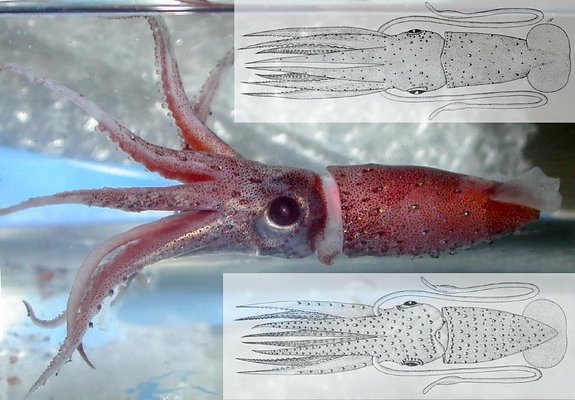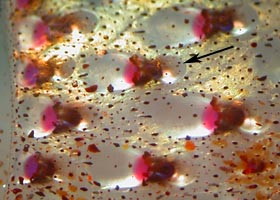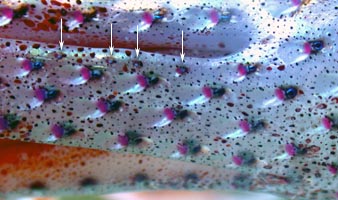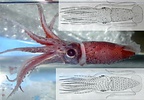Histioteuthis reversa
Richard E. Young and Michael VecchioneIntroduction
H. reversa is one of the most common species of histioteuthids in the North Atlantic. Its range extends into the eastern South Atlantic. The length of the gladius in the largest recorded female is 183 mm (Voss, 1969). Like many histioteuthids, major morphological changes occur at sexual maturity. In this species the females become much more elongate and develop an additional array of photophores.
Characteristics
- Head
- Beaks: Descriptions can be found here: Lower beak; upper beak.
- Beaks: Descriptions can be found here: Lower beak; upper beak.
- Photophores
- Large, compound photophores with posteriorly directed reflectors.
- Arms IV with 4 longitudinal series of photophores on arm base (3 series of large photophores, dorsal series of small photophores
- Terminal group of large photophores on arms absent.
Comments
More details of the description can be found here.Species of the reversa-group are distinguished by the following characters:
- Compound photophores
- Large and small photophores intermixed on ventral surface of mantle .
- 18 photophores (17 large and 1 small) around right eyelid.
- Beak
- Weakly developed median ridge on each lateral wall.
- Tubercles
- Absent.
H. reversa is most easily separated from other members of the reversa group by (1) the arrangement of photophores on arms IV (H. atlantica - 4 series, dorsal series of mixed sizes; H reversa - 4 series, dorsal series of small sizes; H. eltaninae - 3 series) and (2) from H. atlantica by the absence of simple, arm-tip photophores and from H. eltaninae by the short connective complex in their spermatophores and the presence of posterior reflectors (not described for H. eltaninae) on compound photophores.
The above information is from Voss (1969) and Voss, et al. (1998).
Nomenclature
H. elongata (Voss and Voss, 1962), described from a mature female, is a junior synonym (Voss, et al., 1998).
Life History
This series of drawings shows the remarkable elongation in shape of the female at maturity and the maturity-related increase in numbers of simple photophores (dark spots) on the mantle (Voss, et al., 1998)


Figure. Ventral views of growth stages of H. reversa. Top - 39 mm ML, same as title illustration. Middle - 85 mm GL, mature male, 43° 20'N, 59° 27'W. Bottom - 183 mm ML, mature female, 39° 21'N, 70° 41'W. Drawings from Voss, et al. (1998).
The drawings below show the abundance of simple, dark photophores on the head of mature males. To the left is a ventral view, 89 mm ML and to the right is a dorsal view, 107 mm GL (Voss, et al., 1998). These dark photophores are apparent in photographs of a mature male.


Figure. Ventral and dorsal views of the head of a mature male H. reversa. Left - Ventral view, 89 mm ML, 10° 52'N, 22° 09'W. Right - Dorsal view of the head of a mature male, 107 mm GL, 42° 55'N, 62° 13'W. Drawings from Voss, et al., 1998.
Distribution
Geographical distribution
H. reversa occurs throughout much of the Atlantic Ocean but is absent from the Caribbean Sea, the Gulf of Mexico and the South Subtropical Region. Voss, et al. (1998) suggest that the abundance of H. reversa near slopes and submarine topography is related to a preference for high productivity waters.
References
Voss, N. A. 1969. A monograph of the Cephalopoda of the North Atlantic: The family Histioteuthidae. Bull. Mar. Sci., 19: 713-867.
Voss, N.A., K. N. Nesis, P. G. Rodhouse. 1998. The cephalopod family Histioteuthidae (Oegopsida): Systematics, biology, and biogeography. Smithson. Contr. Zool., 586(2): 293-372.
Title Illustrations

| Scientific Name | Histioteuthis reversa |
|---|---|
| Location | Photograph from Northwest Atlantic. Drawings from 41° 27''N, 27° 35''W, 41° 27''N, 27° 35''W |
| Comments | Photograph - Taken in an aquarium aboard ship. Drawings - © 1969 Bulletin of Marine Science |
| Reference | Drawings from Voss, N. A. 1969. A monograph of the Cephalopoda of the North Atlantic: The family Histioteuthidae. Bull. Mar. Sci. 19:713-867. printed with permission |
| Specimen Condition | Live Specimen |
| Identified By | Michael Vecchione |
| Sex | Drawings - Male |
| View | Photograph- side view. Drawings: Top - Dorsal view. Bottom - Ventral view |
| Size | Drawings- 39 mm ML |
| Image Use |
 This media file is licensed under the Creative Commons Attribution-NonCommercial License - Version 3.0. This media file is licensed under the Creative Commons Attribution-NonCommercial License - Version 3.0.
|
| Copyright |
©

|
About This Page
Drawings by Voss (1969) printed with the Permission of the Bulletin of Marine Science.

University of Hawaii, Honolulu, HI, USA

National Museum of Natural History, Washington, D. C. , USA
Page copyright © 2018 and
 Page: Tree of Life
Histioteuthis reversa .
Authored by
Richard E. Young and Michael Vecchione.
The TEXT of this page is licensed under the
Creative Commons Attribution-NonCommercial License - Version 3.0. Note that images and other media
featured on this page are each governed by their own license, and they may or may not be available
for reuse. Click on an image or a media link to access the media data window, which provides the
relevant licensing information. For the general terms and conditions of ToL material reuse and
redistribution, please see the Tree of Life Copyright
Policies.
Page: Tree of Life
Histioteuthis reversa .
Authored by
Richard E. Young and Michael Vecchione.
The TEXT of this page is licensed under the
Creative Commons Attribution-NonCommercial License - Version 3.0. Note that images and other media
featured on this page are each governed by their own license, and they may or may not be available
for reuse. Click on an image or a media link to access the media data window, which provides the
relevant licensing information. For the general terms and conditions of ToL material reuse and
redistribution, please see the Tree of Life Copyright
Policies.
- Content changed 29 March 2018
Citing this page:
Young, Richard E. and Michael Vecchione. 2018. Histioteuthis reversa . Version 29 March 2018 (under construction). http://tolweb.org/Histioteuthis_reversa/19791/2018.03.29 in The Tree of Life Web Project, http://tolweb.org/










 Go to quick links
Go to quick search
Go to navigation for this section of the ToL site
Go to detailed links for the ToL site
Go to quick links
Go to quick search
Go to navigation for this section of the ToL site
Go to detailed links for the ToL site